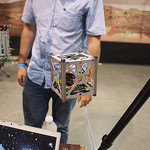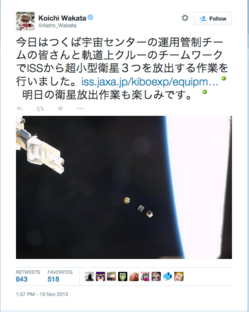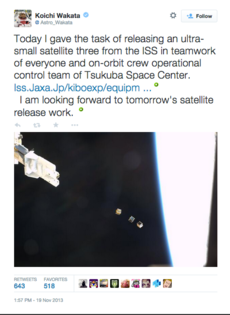I was reading one of my techie newsletters recently and the writer mentioned something of which I had never before heard: CubeSats. I know that there are a lot of things in space of which I have never before heard, but I thought I had heard of the big, important things. As it turns out, CubeSats are not big, but I believe they will play out to be very important.
Update 8/27/2015–See bottom of post for a link to a video of cubesat implementation
Update 1/13/2017–See bottom of post for a link to How to dock CubeSats
First off, what is a CubeSat?
Well, essentially, this:

It really is cube-shaped, and it really is a satellite. Specifically, it is 10 cm x 10 cm x 10 cm (approximately 4 x 4 x 4 in inches), which constitutes 1 Unit (1U); some deployments are 2 units or 3 units (JEM Small). It produces its own power, is designed with solar panels, and is capable of transmitting signals (Keith).
CubeSats were first introduced in 1999 (Keith). (For someone my age that doesn’t sound all that long ago, but it was a decade and a half. The computer I used at that time ran at 333 mHz and had an 8 GB hard drive.) They were designed by California PolyTechnic State University (Keith). CubeSats cost far less than full-scale satellite deployments (and even so aren’t cheap themselves), and so provide launch opportunities for universities and other organizations who have previously been unable to access space (CubeSat). Preparing and deploying a CubeSat, and developing and managing the research conducted with it, helps students in universities, and even in some high schools, begin developing the skills and experience necessary for aerospace work (CubeSat). These projects also help to provide young engineers and aerospace engineering students with education, and with opportunities to perform scientific and technological experiments in space (F-1).
PROJECTS WITH CUBESATS
More than 150 CubeSat projects are either ongoing or completed worldwide, each having an orbital lifetime after release of about 250 days (F-1). As fascinating as this technology is, I won’t tell about each of them; however, I’ve picked out a few that I found singularly worthy of mention.
SkyCube
SkyCube was a Kickstarter project, the brainchild of Southern Stars Group. The deployment lasted 90 days, and funders got an app they could use to follow the satellite, take photos, and tweet from space. At the end of the 90 days, the satellite received a command to inflate a polyethylene balloon using a carbon-dioxide cartridge. The balloon inflated to a diameter of seven feet, making the satellite one of the few visible CubeSats, and it also introduced aerodynamic drag to slow down the orbit and allow the satellite to enter Earth’s atmosphere, burning up harmlessly. To give you an idea of costs, this one ran up about $250,000 (“SkyCube”).
OSSI-1
OSSI-1 is a South Korean project launched aboard the Russian Soyuz 2-1b. The satellite did enter orbit, but the developer is not able at this time to communicate with it (Zorich).
In the Under-100k price range, we have KickSat, which released 104 postage-stamp-sized satellites, called Sprites. They contain a microcontroller, solar cells, and a radio transmitter. This deployment carries a tag of about $75,000 for materials (Zorich).
Now you’re going to start seeing a sort of web of interconnected launches.
Flock 1
Flock 1 is a sort of a constellation of CubeSats whose mission is to generate high-resolution images of Earth. It was designed, developed, manufactured, and operated by Planet Labs in San Francisco, California, which markets Earth Observation Data products to a range of customers for a variety of applications. Flock 1 launched with LambdaSat and MicroMAS, mentioned below (Cygnus).
LambdaSat
LambdaSat is a 1-unit CubeSat built by Lambda Team, an international group of Greek scientists and students based in Silicon Valley (yeah, I know, I got confused by that description, too). The project’s objective is to measure radiation effects on graphene (one of the coolest substances known to mankind–just my opinion) in Low Earth Orbit. It also uses an experimental AIS (Automatic Identification System) for tracking all the vessels inside its footprint around the globe (LambdaSat).
MicroMA
MicroMAS stands for Micro-sized Microwave Atmospheric Satellite. It’s a 3U deployment from MIT’s Space Systems Laboratory, and it was tasked with making observations of the dynamics of hurricanes and other large storm systems. The scientists on this project also hope to demonstrate the advantage of a distributed set of data collectors. (Hil) MicroMAS, Flock 1, and LambdaSat were delivered to NanoRacks for launch, and I’ll tell you a little about them later.
November 19-20, 2013, 3 Sats were deployed from the International Space Station: a 1-unit JAXA deployment called PicoDragon, for Earth imaging; a 1-unit NASA deployment called ArduSat; and a 3-unit deployment called TechEdSat3. ArduSat is a technical validation of an open platform that has a reprogramming function with activation of applications uplinked by regular folks like us. TechEdSat3 is validating an aero braking mechanism called Exo-brake for de-orbiting. (JEM Small)
Koichi Wakata posted a tweet and photo immediately following one of the launches:


GETTING THE CUBESATS INTO SPACE:
The CubeSats are powered off until just before actual deployment, rather than having them “on” when they’re loaded onto the launch vehicles. This allows for any minor repairs and adjustments that may be needed, and it also helps to conserve battery life for the times when the units can’t produce solar power (Keith).
On the ISS, Satellite Install Cases (SICs) are delivered to the International Space Station with pre-installed CubeSats as part of spaceship cargo.SICs are installed on the MPEP, which is then installed on the airlock side. A crew member powers down the MultiPurpose Experiment Platform (MPEP) and plugs in the modules. The platform is powered up, and a data cable from the platform is plugged into a computer to download data. The JEM Small Satellite Orbital Deployer (J-SSOD) attached with the MPEP is transferred to the outboard side. A robotic arm grapples the MPEP and moves it to the release point. The MPEP is oriented to face opposite the ISS direction of travel, as well as a direction that will prevent the orbit of the satellites from interfering with the orbit of the ISS. A spring on the SIC deploys the CubeSats. (JEM Small).
INTERESTED IN PARTICIPATING IN CUBESAT RESEARCH?
The CubeSat Program currently has 60 high schools and universities participating. The program provides a standard physical layout and basic design guidelines; a standard, flight-proven deployment system; coordination of required documents and export licenses; integration and acceptance testing facilities with formalized schedules; shipment of flight hardware to the launch site and integration to the launch vehicle; confirmation of successful deployment and telemetry information (CubeSat). You can get a list of hardware suppliers here.
UPDATE VIDEO REFERENCED AT TOP:
From the European Space Agency: How to Dock CubeSats
WORKS CITED
“CubeSat Mission Statement.” CubeSat.Org. 30 Dec 2014. <www.cubesat.org/index.php/about-us/mission-statement>.
“Cygnus Orb-2 Cargo Manifest.” Spaceflight101. 30 Dec 2014. <www.spaceflight101.com/cygnus-orb-2-cargo-manifest.html>.
“F-1 and companion CubeSats to be deployed to space from Kibo module on September 27.” International Space Station. 21 Sept 2012. 29 Dec 2014. <iss.jaxa.jp/en/kuoa/news/kuoa_120921.html>.
Hil, Helen. “MicroMAS: small is beautiful.” MIT News. 27 March 2014. 29 Dec 2014. <newsoffice.mit.edu/2014/micromas-small-is-beautiful>.
“JEM Small Satellite Orbital Deployer (J-SSOD)”. Japan Aerospace Exploration Agency. 6 Nov 2013. 29 Dec 2014. <iss.jaxa.jp/en/kiboesp/jssod>.
Keith, Lori. “CubeSats in Orbit After Historic Space Station Deployment.” International Space Station. 10 Dec 2012. 29 Dec 2014. <www.nasa.gov/mission_pages/station/research/news/j_ssod.html>.
“LambdaSat.” Gunter’s Space Page. 9 April 2014. 29 Dec 2014. <space.skyrocket.de/doc_sdat/lambdasat.htm>.
Suppliers. CubeSat.Org. 30 Dec 2014. <www.cubesat.org/index.php/collaborate/suppliers>.
“SkyCube Satellite Technology.” Southern Stars. 6 Jan 2014. <www.southernstars.com/skycube/satellite.html>.
Zorich, Zach. “Say Hello to the Little Space Race that Could.” Popular Science. May 2014:70
